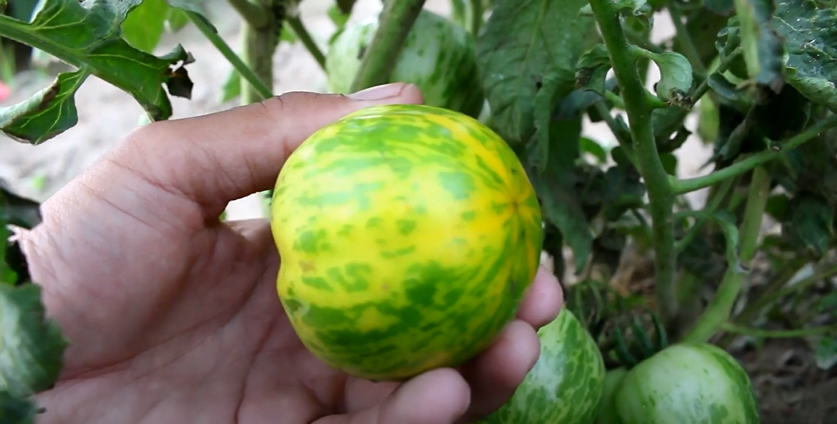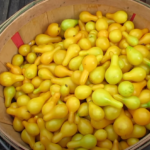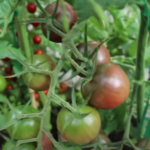Green Zebra tomato is a green tomato cultivar with green flesh and dark to light green vertical stripes which mimic Zebra stripes. Depending on the ripening stage, the stripes shift to light green or yellowish color. This is one of the ways to tell when the fruit is ready to pick. Green Zebra tomato has a tart and sweet flavor profile and is good for salsa and salads. It is considered a green-when-ripe tomato which does not change to red when ripe as occurs with regular red tomato fruit.
Table of Contents
What are Green Zebra Tomatoes?
Although characteristically green, the Green Zebra tomato is a bonafide member of the Solanum lycopersicum species just as other tomato varieties such as Beefsteak, Roma and Yellow Pear. Green Zebra also belongs to the Solanaceae family, commonly known as the nightshade family. Found in this family are everyday vegetables namely peppers, potatoes and eggplants.
Green Zebra tomatoes have comparatively thin skin which is however split resistant. This is in contrast to most tomato varieties with thin skin which nonetheless tends to burst so easily. Concerning shape, the Green Zebra tomato is a relatively small well rounded tomato which weighs between 3 Oz. and 4 Oz. or 80 grams and 120 grams.
Green Zebra tomatoes are used in a variety of culinary recipe applications such as making green paste, salsas, salads, tomato sauces and soups. When ripe, they are juicy tomatoes of lower acid content and a flavor profile that exudes an appreciated balance between tartness and sweetness. Although now largely mainstream, the Green Zebra tomato was once considered a specialty tomato that was popularized by some celebrity chefs.
Why are Green Tomatoes Green?
A certain gene in green tomatoes prevents the formation of lycopene, a compound which turns the tomato to red color. This causes the fruit to maintain its green pigmentation when ripe instead of turning red as other tomatoes would normally do. Green-when-ripe tomatoes such as the Green Zebra remain with some green pigmentation even when ripe due to this biological factor.
A 2008 study published in the journal Plant Philosophy shed light on the mechanism behind certain tomatoes and peppers maintaining green flesh even when ripe as occurs with the Green Zebra. The color transition in tomatoes from green to red when they ripen is caused by what is scientifically referred to as the degradation of chlorophyll and the accumulation of lycopene.
Chlorophyll is what gives the green tomato its color. In some cases, lycopene continues to accumulate in the face of a lack of chlorophyll degradation leading to a muddy brown color as witnessed in some ripened green tomato varieties.
All in all, the failure of Green Zebra tomatoes to turn red also means they lack certain health benefits associated with lycopene as found in ripened red tomatoes (see nutrition and benefits sections).
Green Zebra Tomato Origins
Green Zebra is one of the most recognized heirloom tomatoes. The cultivar was developed by Tom Wagner, a U.S. plant breeder beginning in 1958 and was finally released to the U.S. market in 1983.
The tomato was initially developed by crossing a green tomato called the Evergreen with a certain crack-resistant red tomato. It was later to be crossed with a green-striped red tomato and another heirloom tomato available in catalogs in the 1950s.
Green Zebra tomato cultivar has some 60% stripping intensity according to Tom Wegner. During development some sister cultivars of the Green Zebra tomato had striping intensity ranging between 5% and 80%. According to Wegner “four varieties went into the makeup of the original hybrids and subsequent generations”. The released Green Zebra was chosen for its better crack resistance and flavor.
Green Zebra Tomato Nutrition and Benefits
Green Zebra tomatoes are low in calories and fats and are favored in weight loss diets. According to NC State University Cooperative Extension, ripened Green Zebra tomatoes are a very good source of vitamins A and C as well as potassium. Potassium plays an important role in regulating fluid balance, muscle contractions and nerve signals in humans.
Furthermore, these tomatoes and other ripe green tomatoes provide iron, calcium, dietary fiber, magnesium, and other minerals. The catch is that the tomatoes, although green, must be ripe in order to offer these nutritional benefits.
In addition, NC State University notes that regular tomatoes which are green but turn red when ripe are not similarly good sources of nutrients on account of them being unripen. This is to say ripened Green Zebra tomatoes have greater nutritional value than unripen green tomatoes which turn red when ripe.
Handy Tomato Kitchen Utensils
With the right utensils and equipment, there is much more than can be done with tomatoes in the home kitchen. The following is a list of handy tomato kitchen utensils.
- Tomato strainer
- Tomato/Salsa Blender
- Food Processor for Tomatoes
- Tomato press
- Tomato mandoline for slicing
- Tomato slicer holder
- Heavy duty tomato slicer
- Tomato dicer
- Tomato corer
- Tomato jars for canning
- Tomato knife
- Tomato saver
- Countertop storage basket
- Tomato growing pots
Green Zebra Tomato Recipes
Fried Green Tomato Salad Recipe

This recipe produces nicely coated green tomatoes which are served as part of a salad. Although any green tomatoes would work in this recipe, it is an opportunity to use Green Zebra Tomatoes. Besides, the Green Zebra holds firm even when fried making it suitable for this recipe.
The tomatoes are sliced first and then coated before being fried until they turn a nice brown. The fried quoted tomatoes will later be placed on top of some leafy greens before they are drizzled with buttermilk dressing.
Other ingredients going into this Green Zebra tomato recipe will be lettuce mixes which can be purple lettuce, butter lettuce and Boston lettuce. Extra virgin oil, mayonnaise, sour cream, lemon juice and fresh chives are some of the ingredients to go into the dressing. This recipe takes 30 minutes to make and serves 4. View Recipe.
Green Zebra Caprese Salad Recipe

Caprese salad is an Italian salad which traditionally features sliced mozzarella cheese, fresh tomatoes, and sweet basil which are seasoned with salt and olive oil. Other variations of the recipe use red tomatoes. However, in this recipe ripened Green Zebras are used, nicely sliced up along with the mozzarella.
Take note that if you are to use green tomatoes they must ripened. As another twist, ground black pepper is also added to the recipe. The slices are finally and beautifully arranged in a platter and dressed with the olive oil and basil leaves before serving. You will need only 15 minutes to make this recipe which serves 4 people. View Recipe.
Gluten-Free Green Tomato Gazpacho Recipe
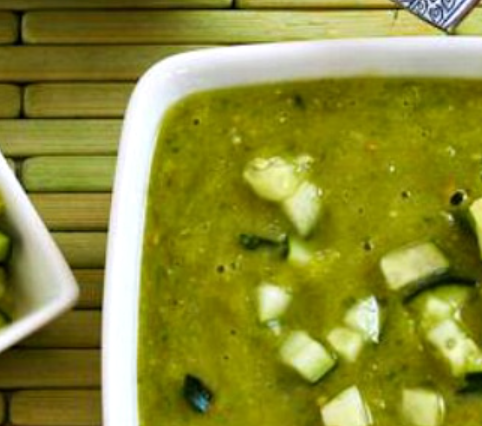
Gazpacho, also sometimes written as Gaspacho, is a blended vegetable summer soup that is served cold. It is widely prepared in Spain and Portugal and has its origins in Iberian Peninsula, southern Europe. Red tomatoes such as Romas or yellow tomatoes can also be used to make this recipe.
However, this particular recipe will be using ripened Green Zebra tomatoes. Other ingredients will be cucumbers which must be bitterless such as English, Persian, Lemon or Armenian cucumbers. The cucumber will be cubed and added as garnish at the end with their skin on, the reason why they should be burpless.
Another ingredient of note will be Green Tabasco Sauce (example). An interesting twist to this recipe is that it is meant to be low carb and gluten-free and thus will have no bread as is the case with the traditional version. View Recipe.
Mild Green Zebra Salsa with Habanada Peppers Recipe
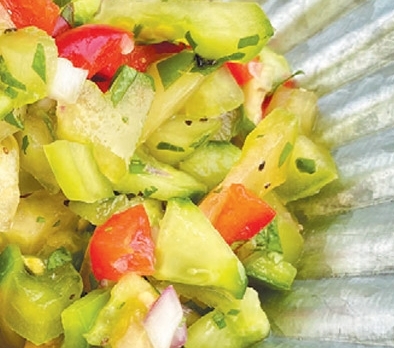
This recipe produces a mild salsa made with freshly picked Green Zebra tomatoes. Salsas fit in many places depending on how they are made. While this one can be served on a burger or with some chips, salsas can also be used in spaghettis, pizzas and even the Mexican dish, Chilaquiles rojos itself.
This mild Green Zebra salsa calls for 5 ripened green tomatoes, cucumber, red onion, cilantro, red bell peppers and unripe mild chili peppers. If you wanted to take the mild sting off altogether, you could also replace the chili pepper with some pimentos. View Recipe.
Green Zebra Tomato Ketchup Recipe
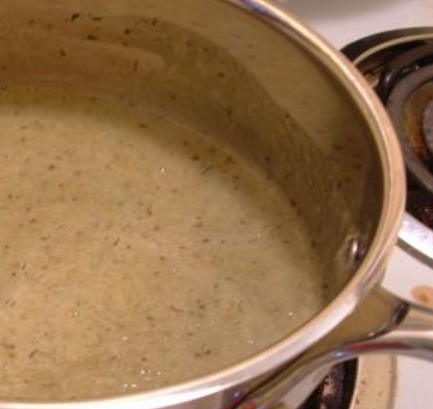
Ever wondered if ketchup could be made using green tomatoes? This recipe does that leaving you with a squeeze bottle suitable green tomato ketchup prepared using the Green Zebra tomato. There are more ingredients that go into this recipe apart from the 5 or so Green Zebras.
Garlic, onion, rice wine vinegar (example), honey, dill, smoked paprika and dill will be some of the other ingredients. The vegetable ingredients will be liquified in a food processor (example) before proceeding to the next stage. The ketchup is ready in 40 minutes and will be enough to fill one squeeze bottle. View Recipe.
Green Zebra Tomato Pasta Salad Recipe
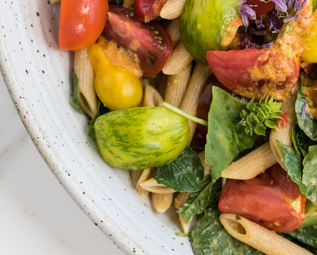
In 20 minutes, following this recipe, will be a colorful pasta salad involving Green Zebra tomatoes and other red and yellow tomatoes. Other ingredients will be caraway seeds (example), fresh basil, fresh lentils, almond milk, lemon juice, garlic and harissa paste (example) among others.
Optional toppings to this salad would be toasted almonds, olives and lentils. View Recipe.
Healthy Green Zebra Tomato Smoothie Recipe
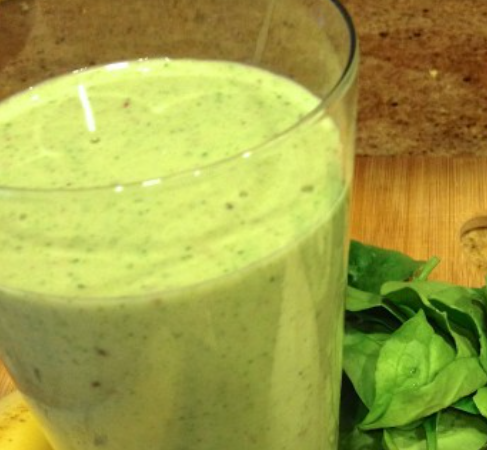
This recipe produces a nutritious Green Zebra smoothie made with a cocktail of fruit and vegetables. The smoothie is estimated to deliver a rich dose of calcium and as much as 130% of daily suggested Vitamins C and A. Ingredients will include banana, pear, baby spinach, swiss chard, kiwi, cucumber and pineapple flavored Greek yogurt.
The ingredients are blended at puree speed to make it smooth and creamy. The smoothie will be served chilled and takes a total of 8 minutes to make. View Recipe.
Green Zebra Tomato Seeds
Saving Green Zebra Tomato Seed
Green Zebra tomato seeds are some of the most widely available gardening seeds in the United States. Apart from procuring commercially available seeds, it is also possible to use seed saved from a previous harvest. Saving Green Zebra seed is similar to saving seed from other tomato varieties.
However, although the Green Zebra is an open-pollinated (OP) heirloom cultivar which is suitable for saving seed, it is important to be sure that you have a true OP Green Zebra tomato whose seeds can be saved. Hybrid tomatoes are not suitable for saving seed because second generation seeds can be sterile or lose the desirable traits of the F1 parents. Learn more about F1 hybrids here from the University of California Cooperative Extension.
Nonetheless, the following are some simple steps to follow when saving open-pollinated Green Zebra tomato seed.
| 1. Get a few ripe Green Zebras and cut them open in half. |
| 2. Core the seeds out of each half into a container using a spoon or tomato corer (example) |
| 3. Rinse the seeds collected in the container with clean water and strain them |
| 4. Put the strained seeds in another container and fill it with water |
| 5. Set aside the container with the seeds covered in water for a few days for fermentation. Fermentation will remove the gel surrounding each seed. |
| 6. After a few days strain the seeds to separate them from the water. The gel on each seed should be gone. |
| 7. Rinse the seeds in clean water and spread them out on a dry piece of paper. |
| 8. The seeds should be completely dry in a day or two. |
| 9. Store the seeds in a labeled paper envelope until ready for use. |
Commercial Green Zebra Seed Suppliers
As earlier mentioned, Green Zebra seeds are widely available in North America. The following is a list of online seed suppliers to consider.
- Green Zebra Tomato Seeds via Amazon
- Baker Creek Green Zebra Tomato Seeds
- Johnny’s Seeds Green Zebra Seeds
- Seed Savers Exchange Green Zebra Seeds
- Park Seed Green Zebra Seeds
- Botanical Interests Green Zebra Pole Tomato Seeds
- Territorial Seed Green Zebra
Growing Green Zebra Tomato
Growing Green Zebra Tomatoes from Seed
Growing the Green Zebra Tomato is very much similar to growing many other tomatoes under the Solanum lycopersicum species. Green Zebras are a warm season crop and will not tolerate very low temperatures and frost. Green Zebra seeds can be started indoors in early spring using a kit (example) aided by bottom heat (example). The seeds must be sown at 0.25 to 0.5 inches or 5mm-1cm deep.
The germinated transplants are put in the ground when night time temperatures are reliably above 45°F to 45°F or 7°C to 10°C. While any decent soil will usually do for growing tomatoes, plant your Green Zebra tomatoes in well draining slightly acidic soils which have a pH of between 6.2 and 6.8. Furthermore, the tomato plants should be in locations that receive full sun or at least 6 hours of full sun per day.
As much as Green Zebras were developed to be crack-resistant, this is only an advantage rather than a license to allow the tomato to go under moisture stress. The soil must be kept moist through regular irrigation or watering. Most tomato varieties split when watered following a period of moisture stress. This should be avoided. Green Zebra tomato fruit is ready to harvest within 80 days. See section below on when to pick Green Zebras.
There is more to appreciate about growing tomatoes in general. We recommend this resource by the University of New Hampshire Extension.
Growing Green Zebra Tomatoes in Pots
Green Zebra tomatoes can be grown in pots. This is, however, done with ease with determinate tomato cultivars compared to indeterminate varieties such as the Green Zebra. The Green Zebra is a vining plant, to grow it in pots will require much larger pot sizes compared to Roma or dwarf type determinate tomatoes. Furthermore, the Green Zebra tomato plant will sooner rather than later require some support in the form of a trellis, stake or cage.
According to Bonnie Plants, indeterminate tomato plants such as the Green Zebra will require a pot size of at least 24 inches or 60cm in diameter (example) or 20 gallons on the fabric pots with handles (example). Unlike fabric containers, all other pots to be used to grow your Green Zebra should have efficient drainage holes to avoid water logging. Fabric pots allow water to drain through the fabric without need for holes.
Soil used to grow your Green Zebras in pots should be nutrient rich and also well draining. Potted plants will require ongoing nutrient replenishing because they lose nutrients through leaching faster than plants growing in the ground. For example, loss of calcium leads to calcium deficiency in tomato plants which is associated with blossom end rot.
The soil in the pot should be kept consistently moist keeping in mind that potted soil tends to turn dry quicker than ground soil because plant roots have limited source of moisture.
Finally, pick the right location for your Green Zebra tomato growing pot which has access to full sun at least six hours a day. Pots with handles such as the fabric ones tend to shine here, at least in the early days, as they make it easier to move plant location as needed.
Keep the potted Green Zebra tomato vine well pruned to encourage healthier fruit and less disease and pests. All in all, growing Green Zebra tomatoes in pots is fairly easy once all the requisite materials and conditions are in place.
When to Pick Green Zebra Tomatoes
When to pick Green Zebra tomatoes is one of the most prominent difficulties faced by first time growers of this type of tomato. The first and obvious indicator is the days to maturity as printed on the seed package. When days to maturity have been reached it also suggests the tomato fruit is within its expected time of ripening.
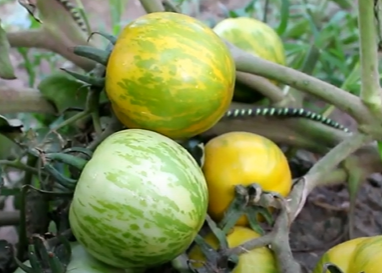
Second, and related to this first indicator is that the Green Zebra tomato displays a color blush from green to yellow which progresses with time. For example, this image shows a raw Green Zebra tomato and a ripened yellow tomato on the same vine.
The yellowish Green Zebra is fully ripe and would over-ripen if left on the vine any longer. Intense yellow on Green Zebra tomatoes is a reliable sign that the tomato has over-ripened.
The third indicator of when to pick Green Zebras is the squeeze test. When ripened, a gentle squeeze of the tomato fruit will yield a slight give. The give is a very good indicator and used by many growers. Used in combination, these signs and indicators are full proof methods of determining when to pick Green Zebra tomatoes.
While red tomatoes can be picked green at first sight of an emerging color blush, Green Zebra tomatoes are best left to ripen on the vine. Fruit that is picked too early will have a bitter taste. Fruit that is picked too late will tend to be mealy. According to the journal Metabolites, tomato fruit that is ripened off the vine is of lower quality than that which is allowed to fully ripen whilst attached to the vine.
According to the journal, this is attributed “in part to the lower levels of fructose and glucose sucrose, which are involved in conferring the sweet taste to fruit”. Regardless of what the journal may say, some growers insist on off-the-vine ripening of tomatoes based on some equally convincing reasons. For more on this debate, we recommend our dedicated article on when to pick tomatoes.
Conclusion
Green Zebra tomato is an open-pollinated heirloom tomato unmistakably identified by its dark to light green vertical stripes which mimic Zebra stripes. The tomato ripens with a golden yellow color and has a citrus-tart flavor. It is used in a variety of culinary applications from salads to making squeeze bottle ketchup. Green Zebra is fairly easy to grow in a home garden and can also be grown in pots or containers of suitable size. The tomato cultivar is well known for its resistance to cracking a tomato fruit physiological issue that plagues a variety of other tomato types.
Random But Good Reads:
